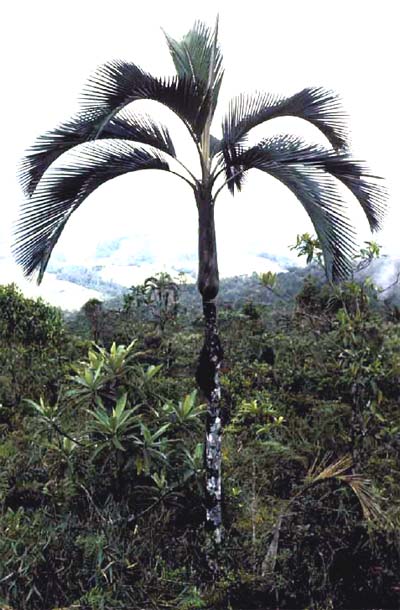Ceroxylon parvifrons Information
A solitary, medium sized, water-loving, slow growing, dioecious palm. Rare in cultivation, scarce in the wild. It has a smooth, greenish waxy trunk, 12 m. (40 ft.) tall, 18 cm. (7 inch) diameter with spaced ring leaf scars, and large segmented, pinnate (feather) leaves, 2.5 m. (8 ft.) long, 0.9 m. (3 ft.) wide, bluish-green above and, yellowish beneath.
Occurs naturally in the wet Andes of South America to 3200 m. (10,500 feet) altitude. The greatest naturally occurring elevation of any palm. The leaf-bases are large and almost form a crownshaft.
Ceroxylon parvifrons can tolerate freezing temperatures to about -3.8°C (25°F). It naturally occurs in open woodland or grassland in sun exposed, montane locations, and should be planted to maximise sunshine exposure. Under extreme freezing conditions we recommend you keep this palm as dry as possible. It should be noted that in its natural habitat the temperature swings between extreme heat and extreme cold occur within 12 hours (night & day) of a single day, and have little to do with Summer/Winter seasons. Therefore, this palm dislikes long durations of cold weather and may require additional heat or protection during the coldest weather.
Identification:
Stem 4-12(-17) m tall, (6-)10-30(-35) cm diameter, usually cylindrical, less frequently very thick at the base and thinner toward the apex, greyish, brown-grayish or brown, covered with a very thin layer of wax. Leaves (8-)12-15(-17), erect, arched, in a hemispheric or funnel-shaped crown; petiole (13-)21-69(-90) cm long, (1.8-)2.5-6.0 cm wide at base, adaxially glabrescent, with ferrugineous, linear, translucent, very long (2-9 mm) scales, surface covered with brown, stiff, scales; rachis (80-)100-180(-270) cm long, notoriously arched, adaxially flattened in half of its length, ending in a well-defined, 0.1-2.0 mm hastula-like projection, distal portion of adaxial surface of rachis covered with white, deciduous scales, and abaxial surface covered with deciduous brown, thin, scales; pinnae (34-)49-84(-96) on each side of rachis, regularly and very closely inserted, arranged in one plane, erect, firm, leathery, plicate, apex inequilateral by 0.5-3.0 cm, adaxially dark green, smooth with the midrib prominent, covered with floccose, deciduous, scales and persistent scale bases, abaxial midrib covered with linear, translucent, brownish scales, surface covered with thick brown-ferugineous, or rarely yellowish scales; Fruits globose, orange-red when ripe, 1.3-2.2(-2.5) cm diam., exocarp smooth; Seeds 1-2 cm diam. This species is surprisingly constant in its morphology. It is easily recognized from a distance by its markedly arched leaves with ascending pinnae, resulting in a obovoid to fountain-shaped crown, its very stiff pinnae, and its smooth and large fruits (up to 2.5 cm). In spite of this morphological stability there are populations with stouter individuals, both in Ecuador (Zamora-Chinchipe, Loja) and in Colombia (QuindÃo, Huila, Tolima), but apparently this trait is not correlated with special ecological factors. Some individuals may also be smaller than usual, with slender stems and smaller leaves, but this reduction in size is apparently associated with very exposed, windy habitats on mountain ridges.
General Information:
Often found with Geonoma undata; both grow at the highest elevations of any palms in the world.
Distribution:
Native to, Bolivia, Colombia, Ecuador, Peru, Venezuela
Widely distributed throughout the Andes from Venezuela and Colombia to Ecuador, Peru and Bolivia, in wet montane forest, at 2100-3150(-3500) m, usually found above 2600 m. Sometimes it forms populations of several individuals. Among the species of Ceroxylon and all palms it grows at the highest elevations in the world (3500 m in Ecuador).
Location: Venezuela, Colombia, Ecuador, Peru, Bolivia (-3.375975°N, -78.837891°E)
Observations
Ceroxylon parvifrons Overlay Image ©2025 Trebrown - No re-distribution without permission.

